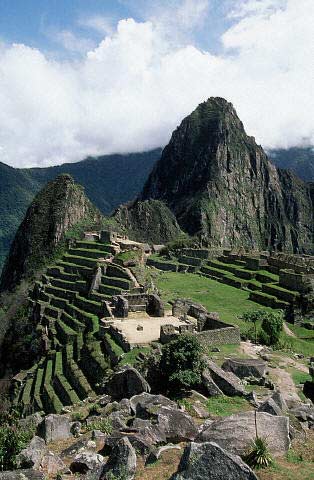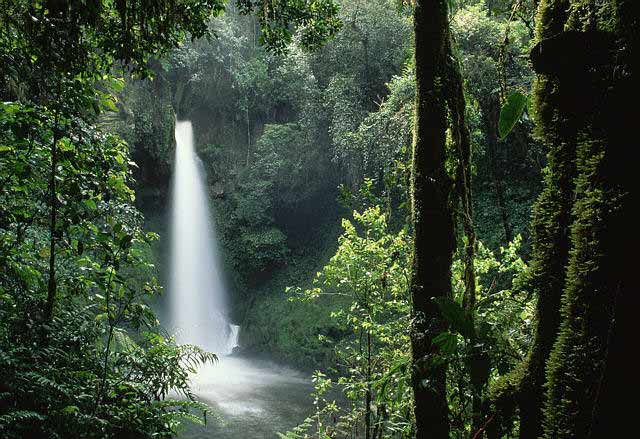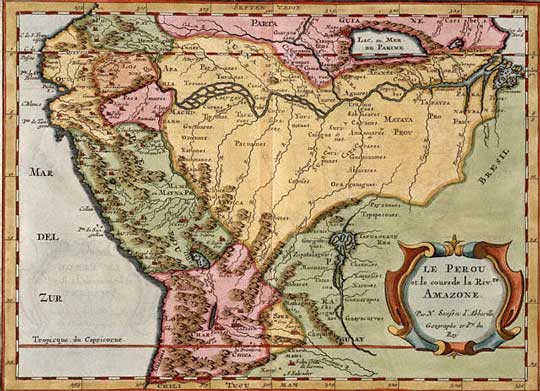for truth is always strange;
stranger than fiction."
- Lord Byron, Don Juan
In 3166 BC, a second catastrophe occured. This catastrophe ended
the "Years of Blood" - the 6,000 years of barbarism
that had ravaged the land since the First Catastrophe.
Just after
this 2nd catastrophe, the Gods returned to Akakor, but only a
few. Their stay was short. Only two brothers stayed: Lhasa and
Samon. Lhasa stayed with the Ugha Mongulala and Samon flew off
to the east.

Lhasa, now king of the Ugha Mongulala, fortified the kingdom
and supposedly had Macchu Picchu built as an outpost of the empire.
"Lhasa was the decisive innovator of the Ugha Mongulala
empire. During the 300 years of his rule, he laid down the basis
for a powerful empire. Then he returned to the Gods. He convened
the elders of the people and the highest priests and passed his
laws on to them. He ordered the people to live according to the
Gods' bequest forever and to obey his commands." After establishing
this powerful empire, "he ascended the Mountain of the Moon,
which looms over Macchu Picchu, and in his flying disk forever
withdrew from the humans."
So what happened to Samon?
Tatunca Nara explained that Samon's empire was a mirror image of Akakor, located by a mighty (Amazon?) river. Lhasa often visited his brother with his flying disk to form a strong link between the two nations. In 3056 BC, he commanded the construction of a great city at the mouth of the Amazon River named, Ofir.
Ofir became a powerful seaport. Here, Samon's empire docked with their valuable cargoes of gold, silver, ancient scrolls, rare woods, fine fabrics, and unknown green stones. Soon, Ofir became one of the wealthiest cities of the empire and also a target for attacks from the tribes in the East.
In repeated attacks, these eastern tribes stormed the the city, raided the ships at anchor and disrupted the communciations with the interior. One thousand years after Lhasa's departure, the empire disintegrated. The savage tribes of the East had succeeded in conquering Ofir and burned it to the ground.
Subsequently, "the Ogha Mongulala yielded the (Atlantic) coastal provinces in the east and withdrew into the interior of the country. And the connection to Samon's empire was severed."

Believed to be located on the borders of Brazil and Venezuela, Akahim was/is "a gigantic stone city shaped like an outstretched finger" that lies behind a great waterfall. It has "lain in ruins for 400 years, though it was in close alliance with Akakor for thousands of years." When the "White Barbarians" began to advance into their territory, the former residents of Akahim sought refuge underground. Apparently, Akahim and Akakor were/are linked together via a subterranean passage...
Tatunca Nara goes on the say that circa 2470 BC the Inca founder of legend, Viracocha (an Ugha Mongulala who apparently had been banished from the tribe for breaking some law) founded the Inca dynasty and built Cuzco. (The Inca Empire would later become a sister nation of the Ogha Mongulala.)
Then, in 570 AD, white, bearded strangers
sailing in long ships with a fierce dragon at the bow came up
the Amazon River. They called themselves
"Goths" (Goths?) and allied themselves with the people
of Akakor. Their sailing ships consisted of iron armor, black
sails, colorful dragon heads and could carry up to 60 men.
But the Germanic tribe of Ostrogoths (a warrior race that conquered Italy within 60 years) were defeated by the East Roman General Narses at the battle of Vesuvius in 522 AD) and the last survivor of this tribe had disappeared without a trace. Linguists claim to have found traces of their language in Southern France and Spain, but there is no definite proof where they migrated.
Well, according to Chronicle of Akakor, the Ostrogoths made an alliance with bold sailors of the north (north?) and ended up in South America. The subsequent union of the Goths and the Ugha Mongulala again strengthened Akakor. The Goths built new defenses and showed the Ugha Mongulala how to make iron and armor.
Eventually, "The White Barbarians" invaded South America and conquered the Incas. Five years later, the Ugha Mongulala withdrew into the inner recesses of Akakor, and according to Tatunca Nara, they departed from Macchu Picchu and ordered their frontier cities abandoned and destroyed.
This helps explain that.
